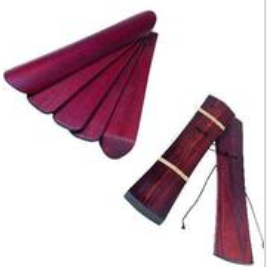Sandalwood production process and method
It is made of mahogany, red sandalwood, pear or litmus. Due to the different purposes of use in the past dynasties, the number of boards is also inconsistent. It usually consists of five or six boards, with a maximum of nine boards and a minimum of three or four boards. Manchu sandalwood boards are mostly two or three (two large and one small) boards. In addition to wooden ones, they are also made of iron sheets. The upper end of each sandalwood board is drilled with two small holes, which are connected in series with thin leather strips or silk ropes, and the lower end can be freely opened and closed.

The handed down sandalwood panels include the Qing Dynasty six-panel sandalwood panels collected by the Palace Museum. They are made of mahogany. Each panel is 40.5 cm long, 7.9 cm wide, 8.5 cm wide and 1.8 cm thick. Both ends are blunt triangles. 1736-1795) products, this sandalwood panel is exactly the same as the sandalwood panel in the music and dance stone carvings in the tomb of the King of Shu before the Five Dynasties.
The five-joint sandalwood panels used in modern Fujian Nanyin are mostly made of lymite. The smaller three panels in the middle are 26 cm to 30 cm in length, 8 cm in width and 2 cm in thickness, and the two slightly larger outer panels are 30 cm to 34 cm in length and 10 cm in width. 3 cm thick, both ends of each board and the outside of the two outer boards are semicircular.
 渝公网安备 50010702504639号
渝公网安备 50010702504639号